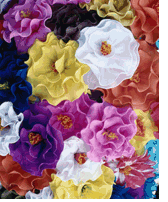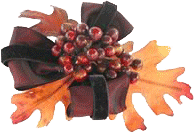The History of Silk Flowers

Interested in a little background information? Here is a brief history of silk flowers for you...
There
has always been interest in recreating the beauty of perishable flowers
in a more permanent form. My own grandmother delighted in creating
zinnias and roses from crepe paper more than 50 years ago.
Proving everything old is new again, these surprisingly life-like blooms
were featured on the cover of the Martha Stewart Weddings magazine in
Spring 2001.
The advent of new polymers and urethanes in the 1960s led to the use of coloured thin foam sheets — certainly more fade-proof than the crepe paper, but perhaps not quite as attractive.
Then came the mass-produced plastic flowers — awful weren't they?
It took quite some time for interest in artificial flowers to rise
again following this low point in their history. However, recent
advances in fabrics, finishes and manufacturing techniques have resulted
in new products which far surpass any of their forebears.
'Silk' has now become a generic term. Most silk flowers are now made from cotton/polyester blend fabrics.
These hold the colour dyes and retain the applied textures well.
However, the quality available ranges greatly, from low-end flowers sold
in discount and craft stores to the new generation blooms. The vast
majority of the world's silk flowers are made in Asia, while a small
tradition of exceptionally high quality handmade blooms remains in New
York and Paris.
Painstaking attention to detail is taken to ensure botanically-correct designs.
The design process now involves taking real flowers apart to closely
examine their structure and observe the details of the stamens, leaves
and calyx.
Fabric choices are based on how they take color and
react to heat — the wide range of reactions is useful for creating
different effects appropriate to different flowers. Special fabric finishes
are often applied to give lifelike textures. For example, ironing the
fabric used to make tulips, to replicate their characteristic shine. The
fabric choice may also be directed by the actual texture of the flowers
represented. Peachskin, a sueded fabric, is suitable for flowers such as magnolia with its velvety petals.

Faux berries are often created from plastic foam painted with enamels for realistic depth of colour and shine (see right). Latex
is being used to craft realistic calla, tiger and oriental lillies much
more pliable and lifelike than the original plastic flowers. A
foam-like polyurethane substance is being used to make tropical
flowers — it's perfect for their chunky, modern look. A recent trend is
roses made from organza, which gives the petals the translucent
look of very full blown blooms. A look, incidentally, which would be
impossible to use in perishable flowers, as they would be far too
delicate to work with at this late stage in their life span.
Improvements in moulding techniques
have been just as important to the faux flower renaissance. Many
manufacturers use actual petals and leaves to create their prototypes,
some create shape and texture from finely-detailed cut and creased tin
foil. Then a plaster cast is taken to create the brass production
moulds. These form and texturise the realistic petals and leaves.
Complex screen printing
techniques are used to add colour, with quality flowers featuring
subtle colour variations to enhance their natural appearance. One of the
latest developments is the inclusion of deliberate 'faults' in
the flower to create a natural realism. Missing petals and pale brown
smudges on outer petals are a clever design device to trick observers
that the flowers originated from the field and not the factory.
This article was reprinted with the permission of the kind folks at www.Loveflowers.com.au. They create lovely wedding bouquets using silk flowers — of course! Thanks, mates!
So, there you have it — the history of silk flowers. They have come such
a long way since grandmother's time. Modern day floral recreations
truly are works of art — and science!
|
Check it out: |

Return from The History of Silk Flowers page
to Silk-Flower-Smart home page
Copyright © 2003-2023 Silk-Flower-Smart.com. All rights reserved.
Unauthorized duplication or publication of any
materials from this Site is expressly prohibited.